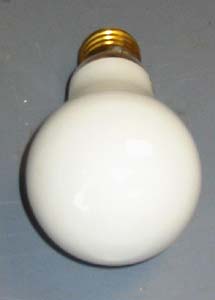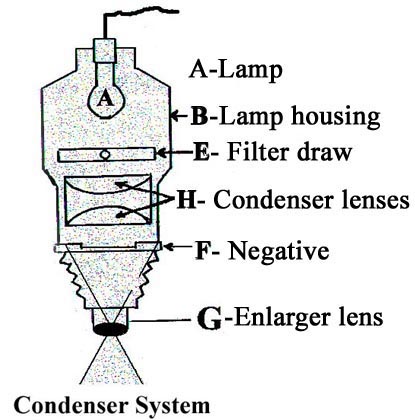Enlarger Illumination - Condenser Enlargers
These enlargers utilize one or more large lens elements below the lamp housing, but above the negative, to focus the light to a point at the elements of the enlarging lens which in turn focuses the image on plane where the paper sits. In a theoretically perfect system, the condenser point of focus is precisely synchronized with the optical center of the enlarging lens. However because of the variations of format, lenses and enlarging distances it is almost impossible to achieve a complete match. To accommodate this, many systems allow the condenser lens position to be altered or the condenser lens to be completely changed with another more appropriate one.
Illumination source
| Usually a special frosted glass tungsten lamp, which has no brand label on the end of the bulb is used for illumination. These are about about the size of a house hold bulb or larger, this coating breaks the light up into thousands of tiny rays of light which are transmitted directly through the condenser lenses, the negative and in turn the enlarging lens. |  |
There are special condenser configurations which use a very small lamp called point light source which produce a different qualify of light.
| These enlargers are much more expensive to make because they incorporate two or even three glass condenser lenses (plano-convex lenses which means that they are flat one side and curved outwards on the other) in the light path that collect and direct the light through the negative in basically one direction. . |
Condenser enlargers are better suited for a range of enlarging requirements and are capable of producing prints of excellent sharpness and contrast.
They have the flexibility, that diffusion can easily be added to the enlarging process in several ways.
*A ground glass diffusing screen can be inserted in the filter draw or just below the condenser lenses
As the light is concentrated into a strong beam of near parallel rays evenly distributed across the entire surface of the negative, these enlargers give a fast exposure time. Because of this concentration of the light, condenser enlargers produce more contrasty prints than diffusion enlargers and this increase is usually about one grade of paper harder, but they exaggerate any negative defects like scratches, dust, fine hairs etc.
Many condenser enlarger have a filter draw that allows the insertion of filters for Multi contrast printing and also CC filters for colour printing.
